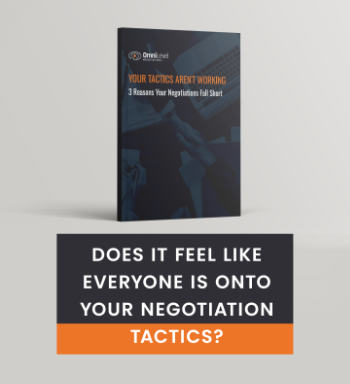Information flows freely until emotions enter the room. Then everything breaks down. Here’s how to fix the circuit.
You know information drives negotiation outcomes. The more specific data you have, the better decisions you can make. But there’s one thing that shuts down information flow faster than anything else—emotional spiraling.
Most professionals are unaware that they’re doing it. You walk into a negotiation with a prepared and logical plan. Then something triggers an emotional reaction, and suddenly you’re making decisions you will regret later.
Here’s the sequence that shows how people make decisions:
Stimulus > Story > Emotion > Logic > Decision
Something happens. You tell yourself a story about what it means. That creates an emotional reaction. that dictates how you feel. You then use logic to justify your feelings. The problem? Once emotions take control, you stop hearing information that contradicts your emotional state.
This leads to poor decisions because you’re only processing inforrmation that supports how you feel. You literally can’t see alternatives.
What Emotional Spiraling Looks Like
Emotional spiraling happens when you cycle between repetitive negative thoughts or get overly optimistic about outcomes. Either direction causes the same problem—you lose objectivity.
A senior sales executive under pressure to meet her quarterly targets hastily entered negotiations. Her counterparty made the statement, “We have your recent offer, and you have to do better.” The story the executive told herself was, “This deal is at risk, the quarterly forecast is at risk, my bonus is at risk.” This put her in an anxious emotional state. She needed a way to eliminate this perceived risk of losing the deal. Her logical response to keep the deal alive was to negotiate against herself and proactively reduce the price of her offer, without securing any additional long-term commitments. The emotional pressure created tunnel vision.
She described feeling anxiety over potential repercussions and self-doubt about her negotiation capabilities after closing a deal with unfavorable terms. The fear of protecting the organization had triggered defensive decision-making.
Four Things That Trigger Emotional Spiraling
Fear: Losing control, being taken advantage of, or damaging important relationships. Business development professionals often experience anxiety over missing out on lucrative deals or concern about agreeing to unfavorable terms.
Lack of Preparation: Not knowing exactly what you want, why you want it, and your investment limits of time, commitment, and money.
Fatigue: Decision-making capacity decreases when you’re tired or in a state of low energy.
Personal Triggers: High-stakes situations, provocative comments like “you’re crazy,” or “you have no idea what you’re talking about.”
How to Fix the Circuit – The Emotional Interrupt
The solution isn’t eliminating emotions—it’s managing them strategically so that information can flow and better decisions can be made.
The Emotional Interrupt (EI) is a statement that acknowledges and reframes the emotionally charged state of another person. The sequence of first acknowledging the emotional state shows empathy and that you understand, but don’t necessarily agree with the other person’s point of view. This is the first step of creating a communication environment where the other person is more likely to hear what you have to say.
Once the other party is open to listening to you, you deliver the Emotional Interrupt to interrupt the “story” the other party is telling themselves about the topic. This changes the conversation from one that is reactive and out of your control to a more thoughtful and emotionally neutral approach.
To restore the emotional balance of others, always go negative.
Our instinct is to confirm and amplify a positive buy signal from our counterparty. “I like what I’m hearing, this can help me,” is answered with “yes, this can help you, and I’m excited to start right away.”
The problem with this exchange is that it’s too early in the process. To create lasting agreements, you need sufficient motivation, acceptance from the decision-makers, and the resources to support implementation. When you start moving forward before confirming all three, you decrease your chances of getting the agreement.
To reduce the chances of creating weak decisions and agreements that ultimately fall apart during implementation, strengthen the commitment to decisions made during negotiations by ensuring they are made from a neutral emotional state.
We do this by using Emotional Interrupt to bring premature positive or optimistic and negative or pessimistic points of view back to reality.
Before the Negotiation
Be clear on your desired outcomes. What you want, why you want it, and when you want to achieve it. Research your counterpart’s likely perspective and concerns to gain a deeper understanding of their needs.
Professionals often feel isolated in decision-making and the weight of safeguarding the organization’s interests. Preparation reduces this pressure.
During the Negotiation
Use Emotional Interrupts to restore balance when emotions escalate—yours or theirs.
When They Go Negative
Example: The other side goes negative and says, “Your proposal is not competitive; your competitor has a better price. Are you willing to match it?”
Don’t: Defend your price or immediately offer concessions.
Do: Go negative and say, “I’m surprised we are still being considered.” Then pause for 5-10 seconds.
That’s the emotional interrupt for your counterparty. They are expecting you to go on the defensive, but you interpreted their thought pattern by going even more negative. They are now more likely to listen to what you say next.
Then say, “If our competitor is still in the picture, that tells me you’re not confident our solution is the best for you. Let’s take a step back and make sure we’re solving all of your problems.”
This approach works by acknowledging their position without agreeing, reframing the discussion from price to confidence and problem-solving, and inviting a collaborative discussion instead of defensive reactions.
When They Get Too Positive Too Early
Your instinct might be to amplify positive signals. They say, “Your proposal looks good. When can we start?”
Instead of jumping forward, interrupt by going negative to slow the momentum: “Thanks, I appreciate your feedback. Before we plan implementation, who else on your side needs to be involved?”
This confirms you have real decision-maker buy-in and available resources before moving forward.
The Goal
The Emotional Interrupt accomplishes three things:
- Recenters emotional states back to neutral
- Creates productive communication environments
- Builds trust through understanding rather than pressure
When emotions hijack negotiations, deals suffer. When you can recognize and redirect emotional spiraling, you regain control of outcomes without damaging relationships.
The circuit breaks when emotions override logic. Fix the circuit by acknowledging emotions while redirecting focus back to information and problem-solving.


